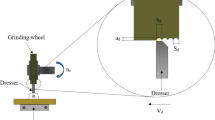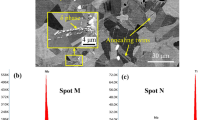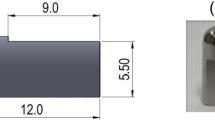Abstract
This article aims at providing a fundamental performance evaluation when grinding Ti2AlNb intermetallics using SiC abrasive. The wheel speed is fixed at 20 m/s while a range of depth of cut (5–20 μm) and workpiece infeed speed (3–12 m/min) are applied. For better understanding, two kinds of common difficult-to-cut materials, i.e., Ti-6Al-4V titanium alloy and Inconel718 nickel-based superalloy are also ground to form a comparison. As for the equal grinding parameters, the normal and tangential grinding forces of Ti2AlNb intermetallics are found to be about twice of those of Ti-6Al-4V alloy, and be only a third and a half of those of Inconel718 alloy, respectively. In addition, Ti2AlNb intermetallics shows more severe tool wear and associated lower G-ratio compared to Inconel718 alloy as a result of strong affinity for SiC abrasives. For the surface integrity, Ti2AlNb intermetallics reveal the same ground surface roughness level, i.e., 0.3–0.6 μm for the applied grinding parameters, with Ti-6Al-4V alloy and Inconel718 alloy. A white layer is easily formed during grinding of Ti2AlNb intermetallics, which adversely affects the machined surface integrity.
Similar content being viewed by others
References
Zhao K, Feng NX, Wang YW (2017) Fabrication of Ti-Al intermetallics by a two-stage aluminothermic reduction process using Na2TiF6. Intermetallics 85:156–162
Priarone PC, Rizzuti S, Rotella G, Settineri L (2012) Tool wear and surface quality in milling of a gamma-TiAl intermetallic. Int J Adv Manuf Technol 61:25–33
Pflumm R, Friedle S, Schütze M (2015) Oxidation protection of γ-TiAl-based alloys—a review. Intermetallics 56:1–14
Hood R, Cooper P, Aspinwall DK, Soo SL, Lee DS (2015) Creep feed grinding of γ-TiAl using single layer electroplated diamond superabrasive wheels. CIRP Ann Manuf Technol 11:36–44
Dey SR, Roy S, Suwas S, Fundenberger JJ, Ray RK (2010) Annealing response of the intermetallic alloy Ti-22Al-25Nb. Intermetallics 18:1122–1131
Li YJ, Zhao Y, Li Q, Wu AP, Zhu RC, Wang GQ (2017) Effects of welding condition on weld shape and distortion in electron beam welded Ti2AlNb alloy joints. Mater Des 114:226–233
Tang F, Nakazawa S, Hagiwara M (2002) The effect of quaternary additions on the microstructures and mechanical properties of orthorhombic Ti2AlNb-based alloys. Mater Sci Eng A 6:492–498
Cai DT, Chen JC, Mao XF, Hao CY (2013) Reheat cracking in Ti2AlNb alloy resistance spot weldments. Intermetallics 38:63–69
Dey SR, Suwas S, Fundenberger JJ, Ray RK (2009) Evolution of crystallographic texture and microstructure in the orthorhombic phase of a two-phase alloy Ti-22Al-25Nb. Intermetallics 17:622–633
Ulutan D, Ozel T (2011) Machining induced surface integrity in titanium and nickel alloys: a review. Int J Mach Tool Manu 51:250–280
Aspinwall DK, Dewes RC, Mantle AL (2005) The machining of γ-TiAl intermetallic alloys. CIRP Ann Manuf Technol 54:99–104
Klocke F, Soo SL, Karpuschewski B, Webster JA, Novovic D, Elfizy A, Axinte DA, Tönissen S (2015) Abrasive machining of advanced aerospace alloys and composites. CIRP Ann Manuf Technol 64:581–604
Xu XP, Yu YQ, Huang H (2003) Mechanisms of abrasive wear in the grinding of titanium (TC4) and nickel (K417) alloys. Wear 255:1421–1426
Guo GQ, Liu ZQ, An QL, Chen M (2011) Experimental investigation on conventional grinding of Ti-6Al-4V using SiC abrasive. Int J Adv Manuf Technol 57:135–142
Zhang ZY, Guo DM, Kang RK, Gao H, Jin ZJ, Meng YW (2010) Subsurface crystal lattice deformation machined by ultraprecision grinding of soft-brittle CdZnTe crystals. Int J Adv Manuf Technol 47:1065–1081
Xi XX, Ding WF, Li Z, Xu JH (2016) High speed grinding of particulate reinforced titanium matrix composites using a monolayer brazed cubic boron nitride wheel. Int J Adv Manuf Technol 90:1529–1538
Zhang YB, Li CH, Zhang Q, Jia DZ, Wang S, Zhang DK, Mao C (2016) Improvement of useful flow rate of grinding fluid with simulation schemes. Int J Adv Manuf Technol 84:2113–2126
Huang H, Zhang YX, Xu XP (2015) Experimental investigation on the machining characteristics of single-crystal SiC sawing with the fixed diamond wire. Int J Adv Manuf Technol 81:955–965
Chandra A, Bastawros AF, Yu TY (2017) Chemical mechanical paired grinding: a tool for multi-wavelength planarization. Int J Adv Manuf Technol 89:611–617
Chen ZZ, Xu JH, Ding WF, Ma CY, Fu YC (2015) Grinding temperature during high-efficiency grinding Inconel 718 using porous CBN wheel with multilayer defined grain distribution. Int J Adv Manuf Technol 77:165–172
Mao C, Zhou X, Yin LR, Zhang MJ, Tang K, Zhang J (2016) Investigation of the flow field for a double-outlet nozzle during minimum quantity lubrication grinding. Int J Adv Manuf Technol 85:291–298
He ZB, Huang H, Yin F, Xu XP (2017) Development of a brazed diamond wire for slicing single-crystal SiC ingots. Int J Adv Manuf Technol 91:189–199
Yu TY, Asplund DT, Bastawros AF, Chandra A (2016) Performance and modeling of paired polishing process. Int J Mach Tool Manu 109:49–57
Dai CW, Ding WF, Xu JH, Fu YC, Yu TY (2017) Influence of grain wear on material removal behavior during grinding nickel-based superalloy with a single diamond grain. Int J Mach Tool Manu 113:49–58
Bentley SA, Aspinwall DK (1997) A comparison of the grinding of IMI318 titanium alloy and a gamma titanium aluminide intermetallic. In: Proceedings of the 32nd International MATADOR Conference, Jul. 10-11; Manchester, p 331-336
Hood R, Lechner F, Aspinwall DK, Soo SL, Lee DS (2007) Creep feed grinding of gamma titanium aluminide and burn resistant titanium alloys using SiC abrasive. Int J Mach Tool Manu 47(9):1486–1492
Malkin S (1989) Grinding technology: theory and application of machining with abrasives. Wiley, New York
Hwang TW, Evans CJ, Malkin S (2000) High speed grinding of silicon nitride with electroplated diamond wheels, part 2: wheel topography and grinding mechanisms. J Manuf Sci Eng 122:42–50
Yao CF, Wang T, Xiao W, Huang XC, Ren JX (2014) Experimental study on grinding force and grinding temperature of Aermet 100 steel in surface grinding. J Mater Process Technol 214:2191–2199
Mao C, Ren YH, Gan HY, Zhang MJ, Zhang J, Tang K (2015) Microstructure and mechanical properties of cBN-WC-Co composites used for cutting tools. Int J Adv Manuf Technol 76:2043–2049
Yu TY, Bastawros AF, Chandra A (2015) Modeling wear process of electroplated CBN grinding wheel. In: Proceedings of the ASME 2015 international manufacturing science and engineering conference, Jun. 8–12; Charlotte, p 1–7
Yu TY, Bastawros AF, Chandra A (2014) Experimental characterization of electroplated CBN grinding wheel wear: topology evolution and interfacial toughness. In: Proceedings of the ASME 2014 international manufacturing science and engineering conference, Jun. 9–13; Detroit, p 1–8
Yu TY, Bastawros AF, Chandra A (2017) Experimental and modeling characterization of wear and life expectancy of electroplated CBN grinding wheels. Int J Mach Tool Manu 121:70–80
Ding WF, Dai CW, Yu TY, Xu JH, Fu YC (2017) Grinding performance of textured monolayer CBN wheels: undeformed chip thickness nonuniformity modeling and ground surface topography prediction. Int J Mach Tool Manu 122:66–80
Zhu YJ, Ding WF, Yu TY, Xu JH, Fu YC, Su HH (2017) Investigation on stress distribution and wear behavior of brazed polycrystalline cubic boron nitride superabrasive grains: numerical simulation and experimental study. Wear 376-377:1234–1244
Author information
Authors and Affiliations
Corresponding author
Rights and permissions
About this article
Cite this article
Xi, X., Ding, W., Fu, Y. et al. Grindability evaluation and tool wear during grinding of Ti2AlNb intermetallics. Int J Adv Manuf Technol 94, 1441–1450 (2018). https://doi.org/10.1007/s00170-017-1005-7
Received:
Accepted:
Published:
Issue Date:
DOI: https://doi.org/10.1007/s00170-017-1005-7




